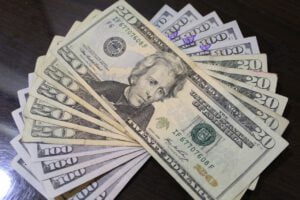By Jacob Wolinsky. Originally published at ValueWalk.

On Thursday, the New York Times, on page one, published an article “U.S. Federal Borrowing Set to Exceed Annual Economy”
Q2 2020 hedge fund letters, conferences and more
Jerome Segal, Presidential Candidate of the Bread and Roses Party, and a former staff member of the House Budget Committee offered this comment:
Unwarranted Concerns About The National Debt
“The Times article contributed to unwarranted concerns about the growing pandemic-induced deficit by failing to make critical distinctions about the National debt and the implications for the economy.”
“The article stated that “the virus downturn… necessitates record amounts of federal borrowing.”
And it called the attention of readers to the views of many economists, that “rising debt as a share of the economy would drive up the amount of money governments must pay in interest to borrowers” and to the potential problems that could result.
“What was missing from the Times account was any discussion of the importance of who it is that the Treasury is borrowing money from. Completely neglected is that the vast amount of the $3 trillion needed to cover the Coronavirus stimulus earlier in the year was actually borrowed from The Federal Reserve — another branch of the US Government. Over the last several months the Federal Reserve’s holding of US Treasury Bonds has gone up around $2.7 trillion.”
“And if the Congress passed another giant stimulus bill, such as the House Democrats are seeking, that money would also be borrowed from the Federal Reserve.”
The Times article was based on a new report from the Congressional Budget Office, “An Update on the Budget Outlook 2020-2030.” Unfortunately, the Times seems to not have penetrated the report fully. On page six of the CBO report, talking about alternative ways of measuring debt, the report says:
“An additional measure, which also excludes Treasury securities held by The Federal Reserve, better reflects the government’s effect on credit markets. In CBO’s baseline projections, the debt net of financial assets and holding of The Federal Reserve increased from $12.9 trillion (or 61 percent of GDP at the end of 2019 to $24.6 trillion (or 80 percent of GDP) at the end of 2030.”
Federal Borrowing And The Size Of The Next Stimulus Package
This is wildly different than the Times headline “Federal debt as a share of the economy, hit 98 percent in the 2020 fiscal year. Unnecessarily the Times report will contribute to the efforts of Senate Republicans to sharply limit the size of the next stimulus package in the current fight against the $3.4 trillion bill passed by the House Democrats.”
Segal added, “In defense of the Times, however, one must note that the Congressional Budget Office report itself uses the term, “Federal debt held by the public” in an extraordinarily misleading way. As used by the CBO, this rightly excludes debt held by the US Government in government trust funds such as the Social Security Trust Fund, but bizarrely does not exclude the vast Federal Reserve holdings. And the CBO report itself should have given far more attention the significance of these unprecedented Fed holdings.”
Segal continued, “Left out of both the Times report and the CBO report, is the really big story, that in truth, what we have been doing is keeping the economy afloat by printing money. It’s only a fiction that we are borrowing it, because we are borrowing from ourselves.”
“The remarkable thing is that this vast experiment in monetary policy, contrary to what most economists have believed for decades, is working, without producing the hyperinflation that has always been expected when the government starts printing vast sums of money to cover its deficits.”
“If there is a lesson here, it may be the realization that we need to re-think not just the basics of economics, but our entire view of what an economy is, and what it is for.”
The New American Dream
Segal’s campaign centers of the question, “What is an economy for, anyway?” and he offers a new definition of the American dream, that rather than higher levels of income and consumption, even fairly distributed, (As Bernie and Elizabeth Warren have urged) that we should redefine the American Dream as:
Having a very, very secure, but modest income, one sufficient to meet essential needs. And because consumption is moderate, having more off-the-job time to be able to pursue a higher quality life, where beauty and creativity abound, with expanding passion-work, whether paid or unpaid, and more time for family, friends, and fun.
Dr. Segal, a University of Maryland-based philosopher, is the author of Graceful Simplicity: The Philosophy and Politics of the Alternative American Dream.
His campaign website is www.SegalforPresident.org and the website of Bread and Roses is www.BreadandRoses.us
The post New York Times Contributes to Debt Hysteria appeared first on ValueWalk.
Sign up for ValueWalk’s free newsletter here.



